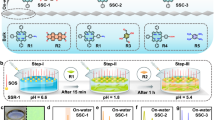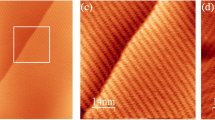Abstract
Selective non-covalent interactions have been widely exploited in solution-based chemistry to direct the assembly of molecules into nanometre-sized functional structures such as capsules, switches and prototype machines1,2,3,4,5. More recently, the concepts of supramolecular organization have also been applied to two-dimensional assemblies on surfaces6,7 stabilized by hydrogen bonding8,9,10,11,12,13,14, dipolar coupling15,16,17 or metal co-ordination18. Structures realized to date include isolated rows8,13,14,15, clusters9,10,18 and extended networks10,11,12,17, as well as more complex multi-component arrangements16. Another approach to controlling surface structures uses adsorbed molecular monolayers to create preferential binding sites that accommodate individual target molecules19,20. Here we combine these approaches, by using hydrogen bonding to guide the assembly of two types of molecules into a two-dimensional open honeycomb network that then controls and templates new surface phases formed by subsequently deposited fullerene molecules. We find that the open network acts as a two-dimensional array of large pores of sufficient capacity to accommodate several large guest molecules, with the network itself also serving as a template for the formation of a fullerene layer.
This is a preview of subscription content, access via your institution
Access options
Subscribe to this journal
Receive 51 print issues and online access
$199.00 per year
only $3.90 per issue
Buy this article
- Purchase on Springer Link
- Instant access to full article PDF
Prices may be subject to local taxes which are calculated during checkout



Similar content being viewed by others
References
Lehn, J. M. Toward complex matter: Supramolecular chemistry and self-organization. Proc. Natl Acad. Sci. USA 99, 4763–4768 (2002)
Balzani, V., Credi, A., Raymo, F. M. & Stoddart, J. F. Artificial molecular machines. Angew. Chem. Int. Edn Engl. 39, 3349–3391 (2000)
Reinhoudt, D. N. & Crego-Calama, M. Synthesis beyond the molecule. Science 295, 2403–2407 (2002)
Fujita, M., Fujita, N., Ogura, K. & Yamaguchi, K. Spontaneous assembly of ten components into two interlocked, identical coordination cages. Nature 400, 52–55 (1999)
Seeman, N. C. DNA in a material world. Nature 421, 427–431 (2003)
Hecht, S. Welding, organizing, and planting organic molecules on substrate surfaces — Promising approaches towards nanoarchitectonics from the bottom up. Angew. Chem. Int. Edn Engl. 42, 24–26 (2003)
De Feyter, S. & De Schryver, F. C. Two-dimensional supramolecular self-assembly probed by scanning tunnelling microscopy. Chem. Soc. Rev. 32, 139–150 (2003)
Barth, J. V. et al. Building supramolecular nanostructures at surfaces by hydrogen bonding. Angew. Chem. Int. Edn Engl. 39, 1230–1234 (2000)
Bohringer, M., Morgenstern, K., Schneider, W. D. & Berndt, R. Separation of a racemic mixture of two-dimensional molecular clusters by scanning tunneling microscopy. Angew. Chem. Int. Edn Engl. 38, 821–823 (1999)
Furukawa, M., Tanaka, H. & Kawai, T. Formation mechanism of low-dimensional superstructure of adenine molecules and its control by chemical modification: A low-temperature scanning tunneling microscopy study. Surf. Sci. 445, 1–10 (2000)
Griessl, S., Lackinger, M., Edelwirth, M., Hietschold, M. & Heckl, W. M. Self-assembled two-dimensional molecular host-guest architectures from trimesic acid. Single Mol. 3, 25–31 (2002)
Dmitriev, A., Lin, N., Weckesser, J., Barth, J. V. & Kern, K. Supramolecular assemblies of trimesic acid on a Cu(100) surface. J. Phys. Chem. B 106, 6907–6912 (2002)
Keeling, D. L. et al. Assembly and processing of hydrogen bond induced supramolecular nanostructures. Nano Lett. 3, 9–12 (2003)
Chen, Q., Frankel, D. J. & Richardson, N. V. Self-assembly of adenine on Cu(110) surfaces. Langmuir 18, 3219–3225 (2002)
Yokoyama, T., Yokoyama, S., Kamikado, T., Okuno, Y. & Mashiko, S. Selective assembly on a surface of supramolecular aggregates with controlled size and shape. Nature 413, 619–621 (2001)
de Wild, M. et al. A novel route to molecular self-assembly: Self-intermixed monolayer phases. ChemPhysChem 3, 881–885 (2002)
Berner, S. et al. Time evolution analysis of a 2D solid-gas equilibrium: A model system for molecular adsorption and diffusion. Chem. Phys. Lett. 348, 175–181 (2001)
Lin, N., Dmitriev, A., Weckesser, J., Barth, J. V. & Kern, K. Real-time single-molecule imaging of the formation and dynamics of coordination compounds. Angew. Chem. Int. Edn Engl. 41, 4779–4783 (2002)
Gimzewski, J. K., Jung, T. A., Cuberes, M. T. & Schlittler, R. R. Scanning tunneling microscopy of individual molecules: Beyond imaging. Surf. Sci. 386, 101–114 (1997)
Cuberes, M. T., Schlittler, R. R. & Gimzewski, J. K. Room temperature supramolecular repositioning at molecular interfaces using a scanning tunneling microscope. Surf. Sci. 371, L231–L234 (1997)
Paraschiv, V. et al. Molecular “chaperones” guide the spontaneous formation of a 15-component hydrogen-bonded assembly. J. Am. Chem. Soc. 124, 7638–7639 (2002)
Prins, L. J., Reinhoudt, D. N. & Timmerman, P. Noncovalent synthesis using hydrogen bonding. Angew. Chem. Int. Edn Engl. 40, 2383–2426 (2001)
Wan, K. J., Lin, X. F. & Nogami, J. Surface reconstructions in the Ag/Si(111) system. Phys. Rev. B 47, 13700–13712 (1993)
Upward, M. D., Beton, P. H. & Moriarty, P. Adsorption of cobalt phthalocyanine on Ag terminated Si(111). Surf. Sci. 441, 21–25 (1999)
Upward, M. D., Moriarty, P. & Beton, P. H. Double domain ordering and selective removal of C60 on Ag/Si(111)-√3 × √3R30°. Phys. Rev. B 56, R1704–R1707 (1997)
Nakayama, T., Onoe, J., Takeuchi, K. & Aono, M. Weakly bound and strained C60 monolayer on the Si(111)-√3 × √3R30°-Ag substrate surface. Phys. Rev. B 59, 12627–12631 (1999)
Takahashi, T., Nakatani, S., Okamoto, N., Ishikawa, T. & Kikuta, S. A Study of the Si(111)-√3 × √3-Ag surface by transmission-X-ray diffraction and X-ray-diffraction topography. Surf. Sci. 242, 54–58 (1991)
Katayama, M., Williams, R. S., Kato, M., Nomura, E. & Aono, M. Structure analysis of the Si(111)-√3 × √3R30°-Ag Surface. Phys. Rev. Lett. 66, 2762–2765 (1991)
Uder, B., Ludwig, C., Petersen, J., Gompf, B. & Eisenmenger, W. STM characterization of organic molecules on H-terminated Si(111). Z. Phys. B 97, 389–390 (1995)
Dewar, M. J. S., Zoebisch, E. G., Healy, E. F. & Stewart, J. J. P. The development and use of quantum-mechanical molecular models, 76. AM1 — a new general-purpose quantum-mechanical molecular model. J. Am. Chem. Soc. 107, 3902–3909 (1985)
Acknowledgements
We thank P. Moriarty and J. O'Shea for discussions, and N. Besley and P. Gill for advice on numerical calculations. This work was supported by the UK Engineering and Physical Sciences Research Council.
Author information
Authors and Affiliations
Corresponding authors
Ethics declarations
Competing interests
The authors declare that they have no competing financial interests.
Rights and permissions
About this article
Cite this article
Theobald, J., Oxtoby, N., Phillips, M. et al. Controlling molecular deposition and layer structure with supramolecular surface assemblies. Nature 424, 1029–1031 (2003). https://doi.org/10.1038/nature01915
Received:
Accepted:
Issue Date:
DOI: https://doi.org/10.1038/nature01915
Comments
By submitting a comment you agree to abide by our Terms and Community Guidelines. If you find something abusive or that does not comply with our terms or guidelines please flag it as inappropriate.



